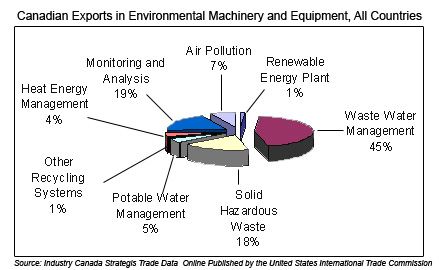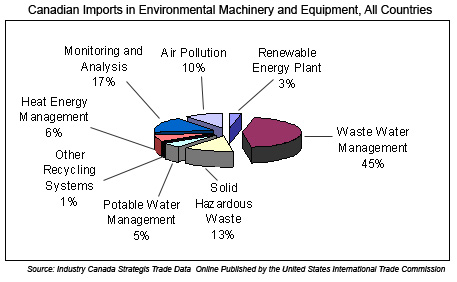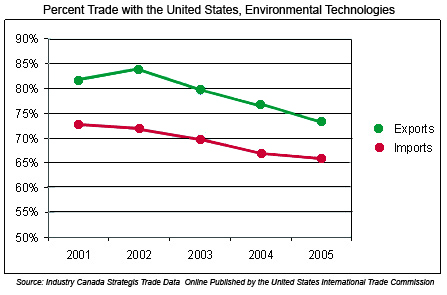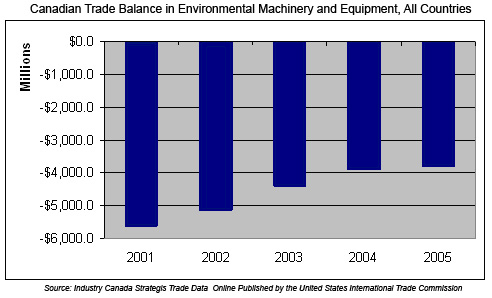Canada's environmental technology trade deficit
 Vancouver, Canada (GLOBE-Net) – Public concern over greenhouse gas emissions, smog and acid rain-forming air pollutants, and contaminated water are spurring efforts by Canadian companies to develop the innovative technologies needed to deal with these problems. While Canada is showing some progress in this regard, we are still far behind other countries in the booming global marketplace for environmental goods and services. Not only are we missing out on important opportunities for economic growth, but we remain dependent on other countries to provide the technologies needed to deal with our own environmental problems. In 2005, for example, our trade deficit in this area exceeded $3 billion. This is hardly acceptable for a country that seeks to be a champion of sustainability in the eyes of the world.
Vancouver, Canada (GLOBE-Net) – Public concern over greenhouse gas emissions, smog and acid rain-forming air pollutants, and contaminated water are spurring efforts by Canadian companies to develop the innovative technologies needed to deal with these problems. While Canada is showing some progress in this regard, we are still far behind other countries in the booming global marketplace for environmental goods and services. Not only are we missing out on important opportunities for economic growth, but we remain dependent on other countries to provide the technologies needed to deal with our own environmental problems. In 2005, for example, our trade deficit in this area exceeded $3 billion. This is hardly acceptable for a country that seeks to be a champion of sustainability in the eyes of the world. The global environmental market, particularly for specialized machinery and equipment, is vast and growing steadily. Industry Canada suggests it will reach $1 trillion by 2015. Canada’s current share of this market is quite small, representing only 3 percent of total spending. In terms of trading activity, Canada is still a net importer of environmental goods and technologies.
Canadian firms exported over $6.7 billion of machinery and equipment used primarily for environmental technologies in 2005. Environmental technology imports amounted to more than $10.5 billion the same year, resulting in a trade deficit of nearly -$3.8 billion.
Broken down by sub-sector, the largest share of environmental exports is waste water management technologies at 45 percent; Monitoring and Analysis technologies second with 19 percent; and Solid hazardous waste exports third with 18 percent.

The largest share of environmental imports is wastewater management technologies (45 percent); Monitoring and Analysis technologies are second (17 percent); and Solid hazardous waste exports third (13 percent).

Trade with the United States accounts for much of both exports and imports of environmental technologies, although the United States’ trade share is declining slowly, as shown below:

While Canadian environmental technology exports are growing and are providing significant national industrial benefits, the overall trade deficit – even though it has been declining in recent years - remains far too high at -$3.7 billion.

Defining the Environment Industry
Part of the problem in assessing Canada’s trade relationships in this sector is the lack of readily comparable data. The environmental technology sector is not the same as traditional industrial sectors such as aerospace or automotive. These sectors are well covered and surveyed annually by Statistics Canada.
The environmental technology sector includes products such as pumps, valves, filters, etc. that normally are classified under more traditional industries.
In fact, the environment industry as such is not defined in the North American Classification of Industries System (NAICS), a standard used by the U.S. and Canadian governments. In the absence of such a standard classification metric, Statistics Canada regards the environment industry as consisting of activities which produce goods and services to measure, prevent, limit, minimize or correct environmental damage to water, air and soil, as well as problems to waste, noise and eco-systems.
The industry also includes clean technologies as well as products and services that reduce environmental risk and minimize pollution and resource use.
According to Statistics Canada, its Business Register contains almost 8,000 establishments that conduct at least part of their business in such environmental activities.
Statistics Canada periodically conducts a survey and publishes data on environmental products and services. The most current data is for 2002, although 2004 data will be forthcoming soon. Statistics that accurately describe international trade in this sector is scarce, which makes it difficult to issue a report card on the industry in this regard.
The United States International Trade Commission (ITC), however, does publish detailed international commodity codes that constitute the environmental technologies sector. The list is not exhaustive, as not all environmental goods are covered. Similarly, some environmental goods have no equivalent commodity code and some commodity codes include goods which are not exclusively environmental goods. For example, the Pump and Compressor industry have significant environmental applications although this equipment is also used in non-environmental applications.
Given these constraints, the ITC have provided commodity codes that they believe are highly applicable for the following environmental technology sub-sectors:
- Renewable Energy Plant
- Waste Water Management
- Solid Hazardous Waste
- Potable Water Management
- Other Recycling Systems
- Heat Energy Management
- Monitoring and Analysis
- Air Pollution
How to boost Canada’s environmental technology sector
Canadian companies have demonstrated considerable ingenuity in developing environmental technologies, and are world leaders in a few niche areas. Given a wealth of natural resources and strong domestic need for these goods and services, there is ample room for Canada’s environment industry to grow and to become a supplier to the international marketplace.
Efforts to encourage import substitution for environmental technologies as well as strong branding of Canadian capabilities to serve foreign markets would help overcome the trade imbalance. This is particularly relevant given that purchases of many environmental technologies are for long term infrastructure undertakings, which once put in place may not be revisited for decades.
The federal government is committed to branding Canada’s environmental technology capabilities and showcasing Canadian ingenuity and technological skills on the world stage. In order for Canada to assume any international leadership in the environmental sector, however, much more has to be done to reverse our dependency upon other countries for the products we use to manage our own environmental affairs.
Canadians like to think of themselves as environmental stewards, and Canada is perceived as such in many parts of the world. The country has shown a strong commitment to sustainability and has demonstrated a capacity to develop energy efficient technologies and innovative solutions to environmental problems.
By leveraging our natural resources and human capital, Canada could become a world leader in environmental protection, and we could stimulate our economy by taking advantage of the booming ‘clean technology’ market, which has been the fastest rising investment sector in recent years.
And while Canada holds a strong position in several areas: hydrogen and fuel cells, carbon capture and sequestration, and sustainable engineering, the trade data noted above reveals that as a net importer of environmental technologies, there is considerable room for improvement in this regard.
The message bears repeating that in order to improve Canada’s environment and to build a more sustainable economy, more investment is required in clean energy and environmental protection technologies, and strong leadership is required both from governments and the private sector to move us forward.
The federal government’s role involves ensuring that consistent goals and objectives are set for all federal departments and that government-wide procurement policies and technology development programs fall under one consistent sustainability framework to overcome the confusion spawned by the existing array of mismatched support endeavours.
Nothing less than a comprehensive, long-term National Environmental Technology Strategy is required, in which government and industry in Canada work collaboratively to enhance our performance, to spur innovation and to increase the uptake of environmental technologies in the marketplace.
The trade statistics used as the basis for this article were assembled by Ken White of Acton White Associates.
For a copy of the tables showing Canada’s environmental technology trade by sector, click here (PDF).
You can return to the main Market News page, or press the Back button on your browser.

